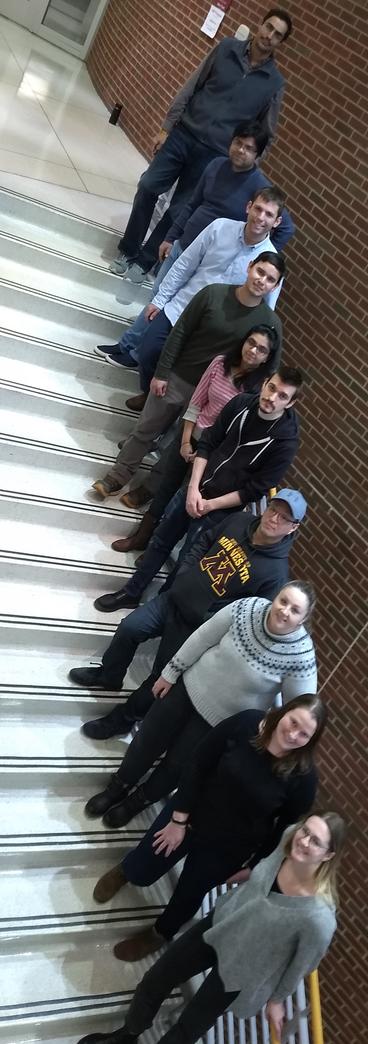
Protein Acrobats 2019

Sivaraj (Shiv) Sivaramakrishnan
Principal Investigator (P.I.)
Professor
Department of Genetics, Cell and Developmental Biology
Director of Graduate Studies- MCDBG Graduate Program
[email protected]
To read more about Shiv please visit his page.

Tejas Gupte
Postdoctoral Fellow
National Centre for Biological Sciences (NCBS), Bengaluru, India, Ph.D.
[email protected]
Almost 4% of the human genome encodes more than 800 GPCRs. Stimuli (ligands) sensed by the plethora of receptors are transduced to the cell, primarily by a limited number of G-proteins. A ligand bound receptor interacts with, and activates, a cognate G-protein; that in turn stimulates a downstream signaling pathway. The conserved general architecture of the interacting interfaces presented by various GPCRs allows for interactions with non-cognate G-proteins as well. I am employing SPASM biosensors to investigate the effect of interactions between receptors and non-cognate G-proteins, on downstream signaling.

Nishaben Patel
Postdoctoral Fellow
Biological Engineering, Indian Institute of Technology Gandhinagar, Gandhinagar, Mumbai, India,
Ph.D.
Myosins, a class of molecular motors, are involved in myriad of essential cellular functions. They are able to achieve this by interacting with different adaptor proteins. Interaction between myosin and adaptor protein is important for various reasons, but in many cases, the exact nature of interaction and regulation remains unknown. I am interested in understanding the role of cardiac myosin binding protein-C (cMyBP-C) in regulation of the cardiac myosin motor. Functioning of the unconventional myosin and its numerous binding partners (GIPC, Dab2, optenuerin) is also of interest to me.

Fredrik Sadler
Graduate Student
St. Olaf College, B.A.
[email protected]
GPCR signaling is a fundamental concept in physiology and disease, but how GPCRs relay signals is highly convoluted. I aim to better define the mechanisms by which GPCRs receive, process, and transduce stimuli.

Keehun Kim
Graduate Student
Kyungpook National University (KNU), Daegu, South Korea, B.S.
[email protected]
The clinical significance of GPCRs is demonstrated in that approximately 40% of all prescription medication on the market target GPCRs. Understanding the mechanism of how drugs elicit their physiological responses through these receptors is crucial if we are to correctly evaluate, design, optimize, and discover new drugs. Currently, biochemical and structural studies of GPCRs lack the ability to fully explain how the binding of drugs to their target GPCRs leads to modulation of multiple downstream responses; while physiological studies fail to provide a comprehensive mechanism of the observed drug-induced responses. My project utilizes molecular and cellular biology, protein engineering, and DNA nanotechnology techniques to understand the biochemical and biophysical aspects that modulate the interaction between GPCRs and G proteins.

Anja Touma
M.D./Ph.D. Graduate Student
Gustavus Adolphus College, B.S.
[email protected]
G protein-coupled receptors (GPCRs) have been the most successful class of drug targets in clinical medicine, due in part to their critical roles in controlling numerous physiological processes including blood pressure and pain. Despite their clinical success, the therapeutic utility of drugs targeting this large class of membrane receptors can be reduced or altered by agonist-induced endocytosis and receptor desensitization. My research project is focused on understanding the role of molecular motors in this spatiotemporal regulation of signaling in the cell. It is becoming increasingly clear that GPCRs are not simply passive hitchhikers on this endocytic pathway, but rather they can regulate their own transport by myosin VI through adaptor proteins, such as GIPC. Through multiplexed regulation of these adaptor proteins, GPCRs can direct their own transport on the endocytic pathway, resulting in the distinct processes of resensitization and desensitization. With a greater understanding for these mechanisms, we can find new ways of altering these processes to improve pharmacological therapy in patients.

Michael Ritt
Scientist / Lab Manager
Michigan State University, B.S.
[email protected]
Molecular motors are necessary for active transportation of cargo throughout the cell as well as the maintenance of certain cellular structures. I'm studying how interaction strength between motor and cargo influences the maintenance of these cellular processes. To do this, I'm using cellular localization tags to target myosin motors to specific cargoes with varying strengths of affinity.